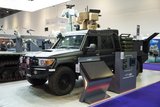ViaSat Selected by US Army to supply next generation Blue Force Tracking
ViaSat Inc. has received a $477 million IDIQ contract to supply the next generation of high speed, high capacity, low latency Blue Force Tracking (BFT) equipment to the US Army as part of the Force XXI Battle Command Brigade and Below (FBCB2) Program. In addition to being selected as the provider for this faster and more accurate command and control satellite communication system, ViaSat also received the first delivery order for $37.7 million to fund deliveries of first article and initial production terminals and other ground networking equipment.
Armed forces use BFT to view regularly updated troop positions on screens in vehicles and aircraft to differentiate between friendly and enemy forces. These awards signal the transition of the BFT program from a proprietary network to BFT-2, an open IP-standard communication network.
Previously, ViaSat had delivered prototype second generation BFT-2 terminals under contract to Northrop Grumman and then a Low Rate Initial Production (LRIP) award from the US Army for system testing. The units met network capacity requirements and demonstrated data throughput that far exceeded specifications. The efficiency gain and latency reduction improve situational awareness and accuracy, and enable satellite channels to accommodate more simultaneous users and messages.
A variety of equipment and services are included in the new BFT-2 awards:
-- Small BFT-2 satellite terminals for a variety of ground vehicles and
small aircraft
-- Hub equipment for high-speed two-way access to ground and airborne
terminals
-- Network Operations Center (NOC) equipment for overall network
monitoring and control
-- Backbone network to connect all FBCB2 NOCs into a single network for
worldwide interoperability
-- Integration with FBCB2 software
-- Engineering services in support of the BFT-2 network
The new BFT-2 system is derived from ViaSat ArcLight mobile satellite communication technology, which enables fast, efficient network access using very small antennas. The ArcLight system provides broadband communications-on-the-move (COTM) service to multiple customer classes, including the ViaSat Yonder(SM) Mobile Broadband service featuring near global coverage. Applications include Internet access, VoIP, and video for private business jets; crew and passenger broadband access for commercial and private maritime vessels through the KVH mini-VSAT Broadband(SM) service; maritime security operations by the US Coast Guard; and real time video feeds from ISR aircraft.
Source: ViaSat
More from Digital Battlespace
-
![Babcock nears first customer for Nomad AI translation tool]()
Babcock nears first customer for Nomad AI translation tool
Nomad can provide militaries with real-time intelligence, saving critical time on the battlefield.
-
![AUSA 2025: Israel’s Asio Technologies to supply hundreds of improved Taurus tactical systems]()
AUSA 2025: Israel’s Asio Technologies to supply hundreds of improved Taurus tactical systems
Taurus operates alongside the Israel Defense Forces’ Orion system which supports mission management across tens of thousands of manoeuvring forces, from squad leaders to battalion commanders.
-
![AUSA 2025: Kopin pushes micro-LED plans as China moves faster]()
AUSA 2025: Kopin pushes micro-LED plans as China moves faster
The plan for the new displays follows fresh investment in Kopin’s European facilities by Theon and an order for head-up displays in fielded aircraft, with funding from the US Department of Defense.
-
![AUSA 2025: Persistent Systems to complete its largest order by year’s end]()
AUSA 2025: Persistent Systems to complete its largest order by year’s end
Persistent Systems received its largest ever single order for its MPU5 devices and other systems earlier this month and has already delivered the 50 units to the US Army’s 4th Infantry Division.
-
![Aselsan brings in dozens of companies and systems under the Steel Dome umbrella]()
Aselsan brings in dozens of companies and systems under the Steel Dome umbrella
Turkey has joined the family of countries attempting to establish a multilayered air defence system with government approval in August 2024 for the effort landed by Aselsan. Dubbed Steel Dome, the programme joins Israel’s Iron Dome, the US Golden Dome, India’s Mission Sudarshan Chakra and South Korea’s low-altitude missile defence system.
-
![DSEI 2025: MARSS unveils new agnostic multidomain C4 system]()
DSEI 2025: MARSS unveils new agnostic multidomain C4 system
MARSS’ NiDAR system has been deployed using sensors from static platforms to provide detection and protection for static sights, such as critical infrastructure, ports and military bases.



























